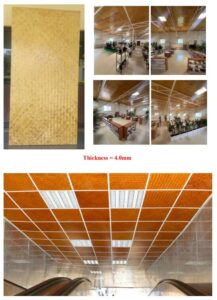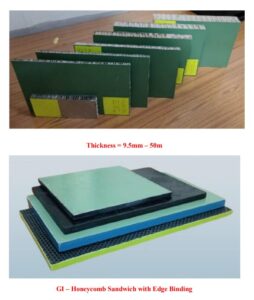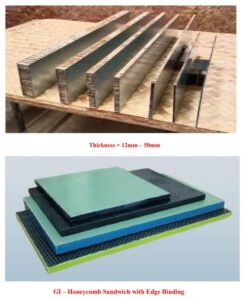In the world of interior architecture and furniture design, materials that combine beauty, sustainability, and performance are increasingly prized. One such innovation is the Natural Bamboo Mat Flexible Board (approx. 1.25 mm thickness) — an engineered bamboo-based flexible board developed using advanced laminated processes. This material is increasingly being positioned as a modern alternative to traditional veneer sheets, offering advantages in sustainability, aesthetics, and engineering performance.
What is the Natural Bamboo Mat Flexible Board?
This board is manufactured using woven bamboo mat, impregnated with phenol-formaldehyde (PF) resin, and hot‐compression moulded using aerospace-derived technology. According to data, these boards feature:
- Thickness of ~1.3 mm (in one variant) with a density of ~740 kg/m³.
- They come in sizes such as 4′ × 8′ sheets for ease of handling.
- The product is described as “eco-friendly and sustainable”.
- Key properties include boil‐water/moisture resistance, non-corrosive behaviour, termite proofing, thermal/electrical insulation and impact resistance.
In practical terms, this means that the board behaves like a flexible laminate rather than a rigid sheet — it can be applied over substrates (such as plywood) for interior decoration, furniture surfaces, wall/ceiling panels, architectural cladding, etc.
Why It Is an Alternative to Veneer Sheets
Traditional veneer sheets
Veneer sheets are thin slices of natural wood (or engineered wood) applied over a substrate such as plywood or MDF. They offer real wood appearance but come with limitations: sensitivity to moisture, higher cost for exotic species, risk of warping or splitting, and sustainability concerns (given long growth cycles of hardwoods).
What this bamboo board offers instead
- Rapid renewable raw material: Bamboo grows far faster than most hardwoods, making it a more sustainable resource.
- Thin flexible format: At ~1.25 – 1.3 mm thickness it can act like a veneer but with engineered layering and enhanced structural properties.
- Improved performance: The laminated board is described as moisture/boil water resistant, termite proof, impact resistant — advantages over many traditional veneers.
- Lightweight & high strength: Density around 740 kg/m³ for the flexible laminate variant.
- Compatibility with manufacturing processes: The material is CNC machinable, can be cut/drilled/joined and bonded using conventional adhesives.
- Aesthetic flexibility: Because it’s engineered using woven bamboo mats, it can offer consistent surfaces, custom finishes (for example painting or polishing), and be used in interior design contexts.
Key Specifications & Properties
Here are the main specification highlights for the flexible bamboo mat laminated board (~1.3 mm variant) and how they translate into performance for interiors:
| Parameter | Value from specification | Implication for interior use |
|---|---|---|
| Thickness | ~1.3 mm (flexible laminate board) | Extremely thin – similar to veneer, ideal for overlay applications. |
| Density | ~740 kg/m³ | Fairly lightweight – reduces load on substrate; easier handling. |
| Moisture / boil-water resistance | Stated as “boil water/moisture resistant” | Useful in humid zones (bathrooms, kitchens), better than many veneers. |
| Termite / fungus proofing | Termite proof, non fungus | Adds durability and longer lifecycle in regions prone to pests. |
| Thermal / electrical insulation and impact resistance | Thermal/electrical insulation, impact resistant | Adds functional benefit beyond just decorative sheet. |
| Compatible with conventional woodworking | Cut, drill, join, glue over plywood substrate | Ease of fabrication and integration into furniture/interior workflows. |
These properties make the board highly suitable for interior applications that demand thin overlays, decorative cladding, and sustainable credentials.
Applications in Interior Design and Furniture
Wall and ceiling cladding
Because of its thinness and flexibility, the board can be applied as a surface finish for walls or ceilings. It offers a natural bamboo aesthetic while providing better moisture resistance than many veneers.
Furniture surfaces & cabinetry
The board can be bonded over plywood or MDF to create furniture fronts, cupboard doors, drawer faces, table tops (light duty) and built-in joinery. The CNC machinability means you can create detailed profiles or designs.
Architectural decorative elements
It can be used for interior decorative panels, ceiling valances, feature walls, partitions and curved finishes (if the board is sufficiently flexible) — enabling designers to bring bamboo texture into interiors without the structural limitations of solid wood.
Interior floors (light duty)
While the specification is for thin board (~1 mm range), for heavier duty floors thicker variants exist (e.g., 4.0 mm sheets) though those would be beyond veneer replacement and more structural.
Eco-friendly interior builds
Because of the renewable bamboo base, this board is suitable for eco-inspired interiors, green buildings, low-VOC certifications, and materials speaking to sustainable goals.
Adaptive reuse & retrofits
The thin overlay makes it ideal for refurbishing existing surfaces (plywood, MDF, etc.) rather than full replacement — which helps in retrofit scenarios where weight, cost, or minimal disruption matter.
Pros & Cons
Pros
- Sustainability: Bamboo is a rapidly renewable resource and the board uses engineered processes.
- Thinness & weight: Near veneer sheet thickness but enhanced performance; lower substrate weight load.
- Performance benefits: Moisture/termite/impact resistance elevate it above traditional veneer sheets.
- Workability: Compatible with woodworking tools, CNC, adhesives — making fabrication easier.
- Aesthetic value: Natural bamboo grain, warm tones, can be finished/polished for premium look.
- Better substrate integration: Because of its engineered nature, more uniform quality than some natural veneers (which can vary in thickness, grain and processing).
- Potential cost advantage: Given faster growth of bamboo compared to hardwoods, long-term cost may be favourable.
Cons / Considerations
- Finish limitations: As a thin board, the underlying substrate matters for structural stability; if substrate flexes, finish may show defects.
- Color stability & UV: Natural bamboo finishes may change colour over time (darkening/lightening) under exposure to UV light — as with natural wood/bamboo panels.
- Edge treatment: Because it is overlay, edges and transitions need good detailing to avoid delamination or chipping.
- Surface durability: While moisture and termite resistance are stated, heavy abrasion or deep impact still could challenge a thin sheet — choice must match use-case.
- Cost vs standard veneer: Although bamboo has cost advantages, the engineering (resin impregnated, hot pressed) may add cost; one should compare total system cost vs standard veneer + substrate.
- Substrate dependency: Since it is a laminate board, the performance is partly dependent on the substrate (plywood/MDF) and adhesive used; inferior substrate could reduce performance benefits.
- Design flexibility: Some bespoke veneer patterns or exotic wood grain aesthetics might still favour traditional veneer for premium luxury finishes; bamboo may have its own grain which may differ.
FAQs (Frequently Asked Questions)
Q: How does this bamboo mat flexible board compare in thickness to traditional veneer sheets?
A: Traditional wood veneers are typically 0.5–3 mm thick, often around 0.6–1.0 mm. The bamboo mat flexible board variant around 1.25–1.3 mm is comparable in thickness while offering the laminated engineered benefits (density ~740 kg/m³, moisture/termite resistance).
Q: Can the board be bent or curved for use on curved surfaces?
A: Because it is a flexible laminate board, it is more amenable to slight curvature than rigid sheets, though the radius of curvature will depend on the substrate and the adhesive system. Always test based on project design.
Q: Is it suitable for high-moisture zones like bathrooms or kitchens?
A: Yes, the specification states “boil water/moisture resistant”. This gives it better suitability than many natural veneers. However, correct installation details (sealed edges, suitable substrate, ventilation) remain crucial.
Q: Can it be painted or stained?
A: Yes — the board can be painted or polished for aesthetic finishes. The engineered surface gives flexibility in design.
Q: What substrates can it be bonded to?
A: The board is designed to be laminated over plywood or similar substrate. It is compatible with conventional adhesives and woodworking joins.
Q: How sustainable is it compared to hardwood veneer?
A: Very. Bamboo is a fast-growing grass that can be harvested in 3–5 years, regenerates from its root system without replanting, and offers environmental benefits (carbon absorption, lower deforestation) compared to slow-growing hardwoods.
Q: What about durability and maintenance?
A: The board offers enhanced durability (termite proof, non-fungus, moisture resistant) compared to many veneers. Maintenance will depend on finish — for example, if polished or sealed properly, surface wear and aging should be moderate.
Q: Are there limitations on a furniture or heavy traffic surface?
A: For heavy duty surfaces (e.g., commercial furniture, flooring), you would evaluate thicker variants or board systems designed for that load. While the thin (~1.25 mm) board is excellent for surfaces and cladding, it is overlaying a substrate. For heavy structural surfaces you may need a thicker panel system.
Conclusion
If you are seeking a material that looks and feels like a premium finish, yet adds sustainability and performance value, the natural bamboo mat flexible board (~1.25 mm) is a compelling alternative to traditional veneer sheets. It bridges the gap between aesthetics, engineering and ecological credentials.
When specifying it for interiors consider the substrate carefully, ensure proper adhesion & edge detailing, and choose finishes that match your design vision and durability requirements. With the right application, it transforms the interiors into spaces that feel natural, modern and responsibly built.






